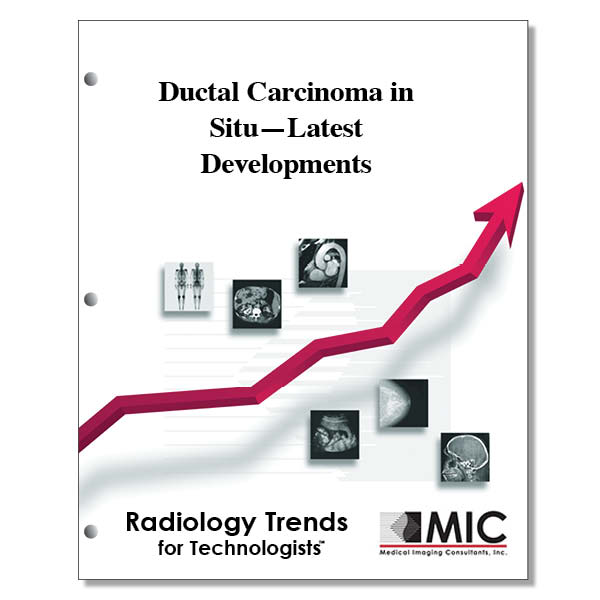

Ductal Carcinoma in Situ—Latest Developments
The latest in the detection, diagnosis and management of ductal carcinoma in situ, including how genomics and imaging offer insights into the progression of the disease to invasive cancer, and our understanding of active surveillance as a management tool are presented.
Course ID: Q00716 Category: Radiology Trends for Technologists Modalities: Mammography, MRI, Radiation Therapy, Sonography2.25 |
Satisfaction Guarantee |
$24.00
- Targeted CE
- Outline
- Objectives
Targeted CE per ARRT’s Discipline, Category, and Subcategory classification:
[Note: Discipline-specific Targeted CE credits may be less than the total Category A credits approved for this course.]
Breast Sonography: 1.50
Procedures: 1.50
Pathology: 1.50
Mammography: 1.50
Procedures: 1.50
Anatomy, Physiology, and Pathology: 1.50
Magnetic Resonance Imaging: 1.50
Procedures: 1.50
Body: 1.50
Registered Radiologist Assistant: 2.25
Procedures: 2.25
Thoracic Section: 2.25
Sonography: 1.50
Procedures: 1.50
Superficial Structures and Other Sonographic Procedures: 1.50
Radiation Therapy: 2.25
Procedures: 2.25
Treatment Sites and Tumors: 2.25
Outline
- Introduction
- Epidemiologic Characteristics
- Pathologic Characteristics
- Progression from DCIS to Invasive Cancer
- Imaging Appearance
- Mammographic Examination
- US Examination
- MRI Examination
- Contrast-Enhanced Mammography
- Overdiagnosis and Overtreatment
- Active Surveillance
- Active Surveillance Trials
- Occult Invasive Disease
- Progression to Invasive Disease
- Conclusion
Objectives
Upon completion of this course, students will:
- know the decade when the incidence of ductal carcinoma in situ began to increase
- state the multidisciplinary work that is rapidly contributing to the understanding of ductal carcinoma in situ
- choose the program that first started to collect epidemiologic data regarding breast disease
- explain the increase is ductal carcinoma in situ up to the year 2000
- outline the incidence of ductal carcinoma in situ for years 2000-2014 in different age groups of women
- understand the incidence of ductal carcinoma in situ among different ethnicities
- explain the primary classification system for grading ductal carcinoma in situ lesions
- explain why nuclear grading is one of the most important discriminating features of ductal carcinoma in situ
- state when nuclear grade is routinely established
- state the percentage of estrogen receptor positive cases of ductal carcinoma in situ
- choose the modality at which estrogen receptor negative cases of ductal carcinoma in situ are more likely to be seen
- explain the relationship between comedo-like necrosis and ductal carcinoma in situ
- list the requirements for a ductal carcinoma in situ diagnosis
- understand the interobserver challenges faced by pathologists
- explain the location of neoplastic cells in ductal carcinoma in situ lesions
- list the cellular models of ductal carcinoma in situ progression
- match the correct cellular models of ductal carcinoma in situ to the evolution of ductal carcinoma in situ and invasive cancer
- list commercially available tools that are designed to predict the risk of cancer recurrence following treatment
- state the most common manifestation of ductal carcinoma in situ
- compare non-calcified ductal carcinoma in situ to calcified ductal carcinoma in situ
- describe how ductal carcinoma in situ manifests at mammography
- explain where fine pleomorphic and fine-linear or fine-linear branching calcifications are more likely to be found
- state the presence of non-calcified mammographically detected ductal carcinoma in situ cases
- list the factors of calcified ductal carcinoma in situ with regard to invasive cancer
- choose the type of calcifications that are associated with benign processes
- understand the process that measures energy shifts in scattered light and can help differentiate the chemical composition of calcifications
- identify the imaging modality with which ductal carcinoma in situ manifests as a hypoechoic irregular hypervascular mass, parallel in orientation without posterior features
- explain which estrogen receptor driven ductal carcinoma in situ cases are more sonographically visible
- discuss the modalities that can best detect noncalcified ductal carcinoma in situ
- identify the imaging modality with which ductal carcinoma in situ manifests as non-mass enhancement
- correlate the difference between ductal carcinoma in situ detected at magnetic resonance imaging and mammography
- choose the most accurate modality for determining the extent of breast disease
- recall the strength of a magnetic resonance imaging scanner that can provide incremental benefits in determining the extent of breast disease
- define active surveillance
- list the current multicenter trials designed to determine which ductal carcinoma in situ lesions are associated with future risk of invasive disease
